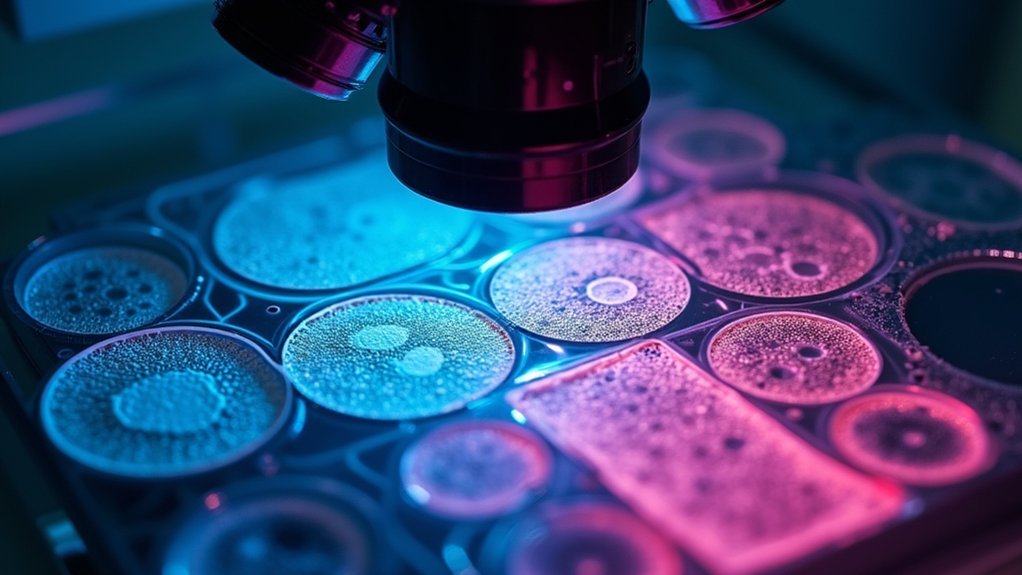Phase contrast photos require different light values because transparent specimens create minimal visible contrast naturally. You’ll need to adjust illumination based on specimen thickness, density, and refractive indices to convert invisible phase shifts into visible contrast. Too much light creates distracting halos, while insufficient light renders details invisible. Using the appropriate light intensity for your specific specimen and objective helps reveal cellular structures that would otherwise remain hidden to the human eye.
The Science Behind Light Values in Phase Contrast Imaging

While conventional microscopy struggles to reveal transparent specimens clearly, phase contrast imaging transforms these invisible differences into visible contrasts through precise manipulation of light values.
When you’re using phase contrast microscopy, the light intensity directly affects how phase shifts are converted into amplitude differences you can actually see in your image.
Your transparent specimens contain various cellular components with different refractive indices that interact uniquely with light.
Cellular landscapes reveal themselves through refractive diversity, allowing light to tell their invisible stories through phase contrast.
To capture these subtle differences, you’ll need to carefully calibrate light values to match your objective’s numerical aperture and condenser annulus. This prevents those annoying halo artifacts around high phase shift details.
Optimizing Exposure Settings for Transparent Specimens
When you’re adjusting light balance for phase contrast imaging, you’ll need to reduce intensity for highly transparent specimens to prevent detail washout while increasing it for denser materials to maintain visibility.
Your specimen’s thickness directly impacts exposure settings, as thicker samples require lower light values to compensate for greater phase shifts that naturally occur through multiple layers.
Proper alignment of condenser phase rings with your objective’s numerical aperture is essential for achieving ideal contrast without introducing unwanted artifacts or requiring excessive light compensation.
Light Balance Techniques
Because transparent specimens barely absorb light, your success with phase contrast photography hinges on proper exposure settings. To achieve ideal light balance techniques on your phase contrast microscope, you’ll need to calibrate illumination settings based on your specimen’s refractive index differences.
| Light Source | Condenser Setting | Best For |
|---|---|---|
| Halogen | Wide aperture | Thick specimens |
| LED | Medium aperture | General purpose |
| Fluorescent | Narrow aperture | Thin specimens |
When working with contrast objectives, regularly assess your light microscopy setup for halos and artifacts that can mask essential details. You can employ differential light adjustment by incrementally changing intensity while observing contrast changes. Remember to integrate longer exposure times for extremely transparent specimens, while adjusting your condenser height to fine-tune phase differences for maximum visibility.
Specimen Thickness Considerations
The thickness of your specimen directly impacts the exposure settings required for successful phase contrast photography. Ideal results come from specimens between 5-10 micrometers thick, where light values can be precisely calibrated to reveal cellular structures without excessive halo effects.
When working with thick specimens (over 10 micrometers), you’ll need to increase illumination to compensate for diminished optical performance. However, this adjustment must be balanced carefully—too much light creates distortion rather than clarity.
For accurate light values across varying specimen thickness, guarantee proper alignment of your phase contrast components, particularly matching the condenser annulus with the phase ring.
Consider the specimen’s refractive index differences when fine-tuning exposure settings, as this affects how light interacts with different cellular features, ultimately determining the contrast quality in your final image.
Condenser Phase Rings
Proper alignment of condenser phase rings with objective phase plates forms the cornerstone of successful phase contrast photography. When you’re working with transparent specimens, the condenser annulus must perfectly match your objective’s phase plate to create ideal light path alignment.
You’ll need to adjust your exposure settings based on the specific phase ring configuration you’re using. Different configurations create varying phase shifts, requiring tailored light value enhancement to capture the full range of contrast in your specimen.
Remember that underexposure loses critical details while overexposure introduces unwanted artifacts in phase contrast microscopy.
Regularly calibrate your condenser phase rings and exposure settings to maintain consistent imaging quality. This calibration becomes especially important when examining specimens with diverse refractive indices, as cellular components interact differently with light passing through your microscope’s optical system.
Light Intensity Effects on Refractive Index Visualization
You’ll notice that light intensity directly affects your ability to detect phase shifts in transparent specimens, with insufficient illumination masking subtle refractive index differences.
The visualization of these differences requires reaching a specific light gradient threshold where phase variations become perceptible against the background.
When you adjust your microscope’s illumination correctly, you create ideal conditions for capturing the refractive index boundaries that reveal cellular structures invisible in brightfield microscopy.
Intensity Impacts Phase Detection
Because light intensity fundamentally drives the visibility of phase differences, mastering its manipulation becomes critical in phase contrast microscopy.
When you’re working with this contrast technique, insufficient light intensity prevents proper phase detection, leaving your images underexposed and lacking the detail you need for accurate analysis.
Higher intensity increases the amplitude of light waves, enhancing the visualization of phase shifts in transparent or thin specimens.
However, you’ll need to find the ideal balance—excessive intensity saturates your detector, introducing artifacts and obscuring critical details, while inadequate illumination fails to highlight essential phase variations.
For live cell observation especially, proper light adjustment becomes essential.
You’ll achieve the best resolution and contrast only when you’ve precisely calibrated your light values to match the specific refractive properties of your specimen.
Light Gradient Visibility Threshold
Light values in phase contrast microscopy establish a definable threshold where refractive index differences become visible.
You’ll notice that proper light intensity directly affects your ability to observe subtle variations in cellular components, particularly in transparent specimens.
When you adjust your light source between 50-100 watts, you’re optimizing the visualization of refractive index differences within your samples.
Too little intensity and you’ll miss fine details; too much and you’ll introduce background noise that obscures critical phase contrast effects.
The visibility threshold represents that sweet spot where light intensity enhances rather than diminishes your observation capabilities.
Calibrating Your Microscope for Ideal Phase Contrast

Achieving ideal phase contrast imaging begins with proper microscope calibration, a critical step that many researchers overlook.
When calibrating your microscope, you’ll need to precisely align the condenser’s annulus with the phase plate in your objective to guarantee maximum light transmission. The light intensity must be carefully balanced—too bright creates halos, while too dim reduces contrast.
- Check that your light source (LED or halogen) provides stable, consistent illumination
- Match your objective’s numerical aperture with the appropriate condenser annulus size
- Regularly inspect optical components for misalignment that affects image quality
- Adjust light values according to the specific objective you’re using
Common Light Adjustment Errors and Their Solutions
Despite your best efforts, phase contrast imaging can quickly deteriorate when light values aren’t properly managed. The most common errors occur when you’re using either excessive or insufficient light intensity.
Too much light creates distracting halos around specimens, while too little light renders phase contrast details virtually invisible.
To solve these issues, always adjust your light based on the specific phase contrast objective you’re using. Each objective requires unique ideal settings to achieve high contrast images.
Don’t overlook regular calibration of your light source and proper alignment of optical components to prevent image distortion.
For fine-tuning, consider adding a neutral density filter to your setup. This allows you to modify light intensity without compromising the phase contrast effect, especially when examining transparent specimens.
Advanced Techniques for Challenging Specimens

Once you’ve mastered basic light adjustment principles, certain specimens still present unique challenges that require specialized approaches. When standard phase contrast fails to reveal adequate specimen detail, you’ll need to employ advanced illumination strategies tailored to specific cellular structures.
- Combine phase contrast with variable light intensities to penetrate specimens with extreme refractive index differences.
- Switch between phase contrast and differential interference contrast (DIC) for specimens where halo artifacts obscure critical features.
- Utilize controlled wavelength selection on your light microscope to enhance visibility of specific cellular components.
- Implement annular diaphragm adjustments with higher numerical apertures for exceptionally transparent specimens.
These techniques often require practice, but they’ll greatly improve your imaging results when conventional methods fall short.
Remember that each challenging specimen may require its own unique combination of light values and contrast methods.
Digital Post-Processing of Phase Contrast Images
While capturing quality phase contrast images begins at the microscope, digital post-processing transforms good images into exceptional ones by enhancing essential details.
You’ll need to adjust light values strategically to compensate for optical artifacts like halos that often obscure critical specimen features.
By manipulating brightness and contrast settings, you can reveal structures that might otherwise remain hidden in your phase contrast images. This is particularly valuable when examining transparent or unstained samples.
Software tools allow you to fine-tune exposure levels to highlight specific cellular components or distinguish between overlapping structures.
Proper calibration during digital post-processing guarantees that subtle phase shifts are accurately represented, leading to more reliable data interpretation.
These adjustments aren’t merely cosmetic—they’re crucial for extracting the maximum scientific value from your microscopy.
Frequently Asked Questions
What Happens to Light Rays in a Phase Contrast Microscope?
In a phase contrast microscope, light rays pass through your specimen, experiencing phase shifts due to varying refractive indices. They’re then modified by the phase plate, converting these shifts into visible brightness differences.
What Light Does Phase Contrast Microscope Use?
Phase contrast microscopes typically use halogen or LED light sources. You’ll find these provide consistent illumination needed to create phase differences. The light passes through an annular diaphragm that enhances contrast in transparent specimens.
How to Obtain a Good Image Under a Phase Contrast Microscope?
To obtain a good image under a phase contrast microscope, you’ll need to properly align the condenser, match the annulus to your objective’s numerical aperture, adjust light intensity appropriately, and use phase-specific objectives marked with Ph inscriptions.
Why Is Green Light Used in Phase Contrast Microscopy?
Green light enhances visibility in phase contrast microscopy because it matches your eye’s peak sensitivity, reduces chromatic aberrations, and maximizes contrast for transparent specimens. You’ll see cellular structures more clearly with green illumination.
In Summary
You’ve now seen why phase contrast photography requires precise light adjustments. By fine-tuning your light values, you’ll reveal transparent specimens that would otherwise remain invisible. Remember, it’s not about brightness alone—it’s about creating the perfect phase shifts that transform refractive differences into visible contrast. With practice, you’ll intuitively adjust your settings to capture stunning phase contrast images that reveal microscopic details with remarkable clarity.





Leave a Reply